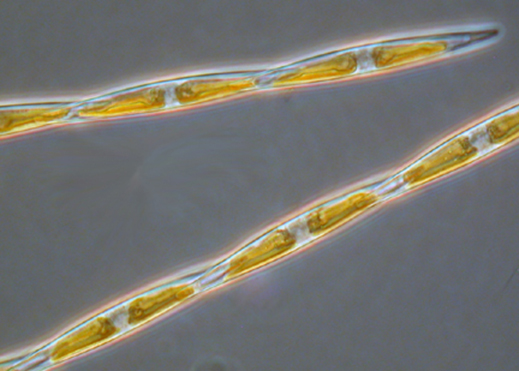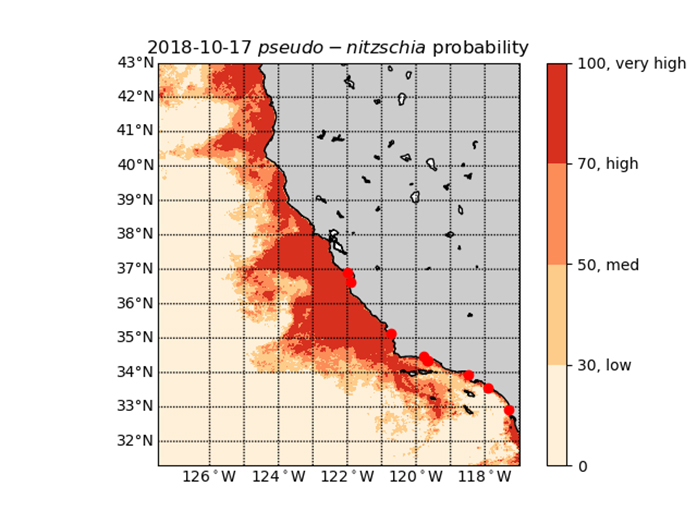
This project will enhance an existing regional coastal model to understand the relative importance of land-based inputs on the frequency and severity of harmful algal blooms and their impacts in the Southern California Current System. Model results can help coastal zone managers explore implications for marine resource management and pollution control.
Why We Care
Within the California Current System (CCS), the harmful alga Pseudo-nitzschia, and its potent neurotoxin domoic acid, have recently caused the closure of key fish, bivalve, and crab fisheries and resulted in marine mammal strandings along the U.S. west coast. Marine resource and water quality managers concerned with these trends in toxic Pseudo-nitzschia blooms have identified two key management questions: (1) What are the marine habitats that are the most susceptible to Pseudo-nitzschia blooms? and (2) to what extent do land-based sources of pollutants exacerbate the problem? Managers need to understand the causal linkage between nutrient inputs and Pseudo-nitzschia toxic blooms. Moreover, managers need to consider whether any of their actions can influence Pseudo-nitzschia blooms and toxicity.
We propose to develop an integrated model for the Southern CCS that will include climate variability, coastal circulation, and nutrient linkages to Pseudo-nitzschia blooms and domoic acid production. Model results can help elucidate relationships between coastal management actions aimed at reducing nutrient inputs to coastal waters and Pseudo-nitzschia blooms.
Animation of Algal Blooms Along U.S. West Coast from January to December
This animation shows the results of a simulation of annual conditions in the California Current. The dark red colors indicate higher levels of chlorophyll, a pigment that tracks levels of algal production. As the year goes from January to December, the model results show how algal blooms develop close to shore and the dynamics of their production.
What We Are Doing
We have funded a team of researchers led by the University of California at Los Angeles who will adapt an existing realistic regional physical-biogeochemical model of the CCS to enable predictions of domoic acid production from Baja Mexico to the California–Oregon Border. The team will use the integrated model to investigate the relative importance of anthropogenic inputs and temperature on the frequency and severity of Pseudo-nitzschia blooms and associated domoic acid events in the Southern CCS. The researchers will transmit these findings to coastal zone managers to help them explore implications for marine resource management and pollution control.

Benefits of Our Work
Water quality and resource managers have a common need for validated, process-based models to assess susceptibility of coastal resources and evaluate the efficacy of management actions. This project proposes to develop an integrated model for the Southern CCS that, once validated, can begin to support management decisions regarding toxic Pseudo-nitzschia blooms. Water quality managers may use model results to decide whether to impose monitoring requirements, determine whether impairment exists and causes of impairments, and develop water quality regulatory management. Fisheries managers may make recommendations to monitor and manage essential fish habitat, modify existing reserves and reserve management, and institute seasonal closures of shellfish beds and fisheries. Land managers may issue or deny permits for coastal development and identify appropriate mitigation actions.
This project is integrated with the California Ocean Protection Council, a cooperative organization of federal and California marine natural resource managers. It will also link to the Harmful Algal Bloom Monitoring and Alert Program, a coordinating committee of harmful algal bloom researchers in California, water quality managers, shellfish management related to public health, animal rescue communities, universities, state and local agencies who support harmful algal bloom and biotoxin monitoring and reporting. Finally, members of the research team have close relationships with all of the state’s coastal Regional Water Boards and their regulated communities, who collectively discharge anthropogenic nutrients to California’s coastal waters.
